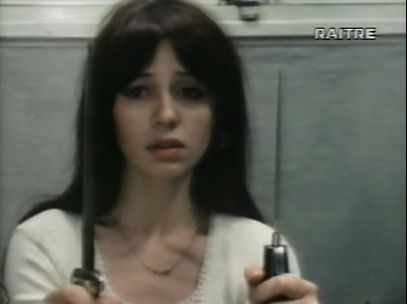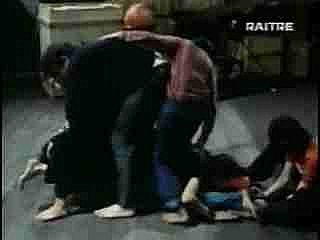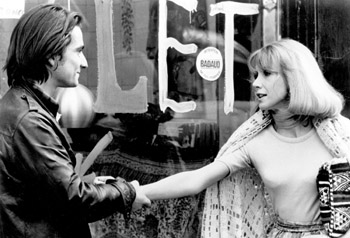From the Chicago Reader (May 25, 2007). — J.R.
OUT 1 ****
DIRECTED BY JACQUES RIVETTE | WRITTEN BY RIVETTE AND SUZANNE SCHIFFMAN WITH PIERRE BAILLOT, JULIET BERTO, MICHEL DELAHAYE, JACQUES DONIOL-VALCROZE, FRANCOISE FABIAN, HERMINE KARAGHEUZ, BERNADETTE LAFONT, MICHELE MORETTI, AND ERIC ROHMER
WHEN Sat 5/26, 2:30 PM (episodes 1 and 2) and 7 PM (episodes 3 and 4); Sun 5/27, 2:30 PM (episodes 5 and 6) and 6:45 PM (episodes seven and eight)
WHERE Gene Siskel Film Center, 164 N. State
PRICE $30
INFO 312-846-2600
MORE Box meals from Whole Foods will be available during dinner breaks for $10, but must be ordered by Thu 5/24.
***
QUESTION: Why did you choose the title Out?
RIVETTE: Because we didn’t succeed in finding a title. It’s without meaning. It’s only a label. — from a 1974 interview
Jacques Rivette has made several good films and four great ones, consecutively: L’Amour Fou (four hours, 1968), Out 1 (12 hours, 1971), Out 1: Spectre (four hours, 1972), and Celine and Julie Go Boating (three hours, 1974). It’s not their epic length that sets these apart from the rest of his filmography — there are others by Rivette that are plenty long — but their improvisatory nature. And while the actors are responsible for much of the creativity, these are the director’s most obsessive works: every shot and scene is set up more as a question than an answer, hinging on the adventure and mystery of not knowing what will happen next.
In most other ways, however, these four films couldn’t be more different. L’Amour Fou is a love story and psychodrama and Celine and Julie an eccentric fantasy-comedy. Out 1 and Out 1: Spectre are philosophical parables about solitude and community in and around Paris during the spring of 1970; they share the same source material, but Spectre‘s tone is quite different — closer to nightmare than comedy, a poetic evocation of a frightening void rather than a void filled with people. For me they’re the most profound films ever made anywhere about the utopian dreams of the 60s and the disillusionment that followed.
Planned as an eight-part serial for French state TV, which refused to air it, Out 1 was screened once as an unprocessed work print at Le Havre over two days in 1971 — a legendary event — and then disappeared for the next 18 years. Rivette spent most of a year editing the footage into Spectre, but he wasn’t making a digest: certain shots from one version appear in the other with radically different placements and meanings. Spectre, which opened in Paris in 1974 and screens at the Gene Siskel Film Center early next month, was my first encounter with the material. It’s only a third the length of Out 1, but, ironically, it’s the more difficult of the two. Seeing both versions together is a revelation.
I attended the world premiere of the processed Out 1 at the Rotterdam Film Festival in early 1989, a decade after I’d edited a book on Rivette that partially focused on the film. (It’s out of print now, but the contents are available at http://www.dvdbeaver.com/rivette/ok/interviews.html.) By this time the film was sort of a running joke among people who’d never seen it, many of whom seemed not to understand that it was a miniseries and just thought it was an outrageously long movie. The screening was total dream fulfillment for a cinephile, but I was shocked when only four or five others showed up for it, so it’s been gratifying to see it more recently become not just available but fashionable — the adventure it was always meant to be. When it showed in London with English subtitles a little over a year ago, more than 100 people attended, as reported in the New York Times by Dennis Lim, who flew over to join them. Last September it was shown twice in Vancouver (where I saw it a second time, this time with subtitles). Then in December, after a single screening sold out in New York, the Museum of the Moving Image scheduled another. And this weekend, Chicagoans will have their chance to check it out whole at the Film Center, where it’s playing over two days with meal and rest breaks.
Each of the serial’s eight episodes is titled as a relay between two characters, suggesting a chain of successive links: “From Lili to Thomas,” “From Thomas to Frederique,” “From Frederique to Sarah,” “From Sarah to Colin,” and so on. The explanation of who these people are is much of the story — and because their identities keep changing, we’re often confounded. Lili (Michele Moretti) and Thomas (Michel Lonsdale) are in separate theater groups, each preparing plays by Aeschylus, Seven Against Thebes and Prometheus Unbound. Thomas is the director of his state-run company; Lili’s is an independent, directorless collective. Frederique (Juliet Berto) is a solitary working-class flirt who cons people out of money. Sarah (Bernadette Lafont) is a novelist working in a country house near the ocean (and an old pal of Thomas). Colin (Jean-Pierre Leaud) — an apparent deaf mute who communicates with a harmonica — begs for money in cafes until a member of Lili’s collective, for no stated reason, hands him a slip of paper with an enigmatic message, and Colin, alone in his furnished room, undertakes to decode it.
I believe this is the first moment when two seemingly unrelated plot strands connect. Then gradually, as in a vast novelistic fresco, more crisscrossing intrigues emerge — some of which include a lawyer (Francoise Fabian), another member of Lili’s group (Hermine Karagheuz), and a hippie boutique owner (Bulle Ogier) with a dual identity who provides the name for episode six, “From Pauline to Emilie,” all by herself — until all strands are intertwined. Eventually Frederique steals a batch of letters that point her in the direction of the same mystery Colin is investigating: a clandestine group of 13 people from different sectors of French society who, inspired by Balzac’s Histoire des Treize (gracefully explained here by Eric Rohmer, in the role of a literary scholar), have come together to control Paris. Or perhaps the group has never existed as anything but a plan, one abandoned after the failed French revolution of 1968. Colin and Frederique have different reasons for their pursuits — his are intellectual, hers are mercenary; their paths cross only once, and very briefly at that.
This much of the story was set up by Rivette (with assistance from the late Suzanne Schiffman, a key figure of the French New Wave who also worked as a major assistant to Truffaut and Godard); he then staged encounters between various actors in separate scenes, asking them to furnish the action and dialogue. By deliberately mixing disparate acting styles, some of these suggesting different modes or versions of reality, he begins to broach the deeper question of what we accept as real. The choices between solitude and community are positioned like separate themes in a fugue: separately and independently, the sad, tormented figures of Colin and Frederique briefly emerge from their cocoons before retreating again. Both the theater groups and the group of 13 expand, contract, converge, or dissolve, as unpredictably fluid as life itself. All that remains the same is the world, a vexing puzzle that persists as Rivette’s only true subject. This is why he could only settle on a label for his epic; a title with a concrete meaning would be too much.




